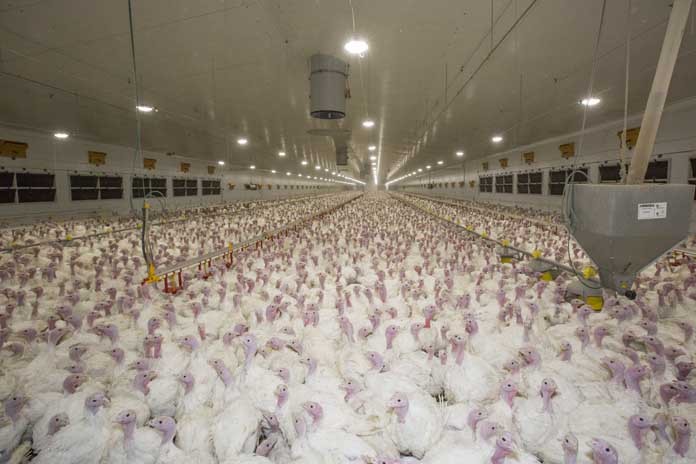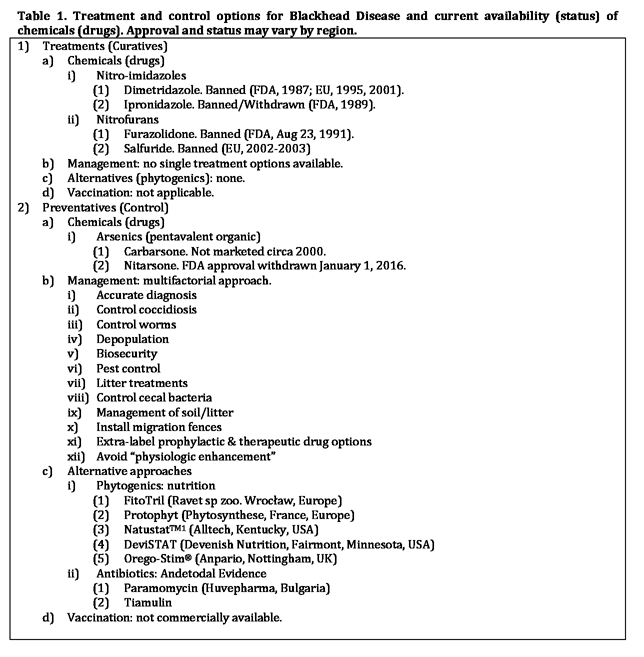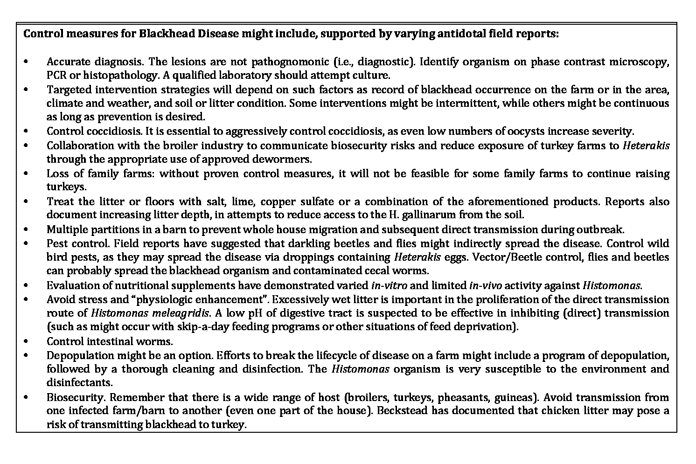
A turkey health survey of US veterinarians in turkey production ranked blackhead position #13 (#11 prior year) compared to #22 in 2006; the survey ranked and scored 36 current disease issues (1= no issue to 5 = severe problem) and had a survey response (reply) of 100% (n=25). Blackhead, also known as Histomoniasis, is one disease with no efficacious drug approved for use in turkeys.
There were 55 reported cases of blackhead (2015) an increase from 61 the prior year, and a record 108 in 2010. Histomoniasis occurs regionally and seasonally in turkeys, and can result in significant mortality. Dimetridazole was extremely efficacious and previously approved for use in turkeys for the prevention and treatment of blackhead; it was banned in 1987.
The lack of any legal treatment for histomoniasis is of concern, especially in the case of valuable turkey breeder candidate flocks. Losses to blackhead have been severe in several areas of Europe, and sporadic cases are occurring in North America. On April 1, 2015, the sponsor announced that it would discontinue marketing nitarsone, and the approval of of nitarsone in animal feed were withdrawn as of January 1, 2016; following this action, there are no FDA-approved, arsenic-based drugs for use in food producing animals. Nitarsone was FDA approved for the prevention of histomoniasis (blackhead disease) in turkeys and chickens, and was the only approved animal drug for this indication. There are neither effective nor approved products for treatment of blackhead outbreaks. Under the announced FDA phase-out plan, the strategy allowed affected producers the opportunity to consider alternatives for managing this disease in the future.
Blackhead Disease, also known as Histomoniasis, is caused by Histomonas meleagridis, a flagellated protozoan. Classically indirect transmission is accepted, whereas the bird ingests embryonated ova of cecal worms (Heterakis gallinarum) that contain the Histomonas organism. Histomonas meleagridis is pleomorphic; in the cecum Histomonas is flagellated whereas in tissues (cecal wall, liver) it is a strictly amoeboid organism. Heterakis gallinarum, also known as cecal worm of poultry, acts as an intermediate host. A new parasitic cycle starts with the intake of ceca-dwelling forms of the protozoa Histomonas meleagridis by adult cecal worms in the ceca of the turkey.
New research and field observations support the opinion that direct transmission is possible as well where the Histomonas are able to infect turkeys for a short period after being excreted. Since oral transmission seems impossible, it has been demonstrated that the mechanism for this is “cloacal drinking”. Dr. McDougald suggests that the Histomonas protozoa in the feces, directly infects new turkeys via the cloacal route, and can spread rapidly through the flock.
Past
Dimetridazole was approved for use in turkeys for the prevention and treatment of blackhead (histomoniasis, infectious enterohepatitis), and for increased weight gain (growth promotion) and improved feed efficiency. CVM had documented evidence that dimetridazole medicated premix and dimetridazole soluble powder had been used widely for the treatment and prevention of swine dysentery. This use of dimetridazole in swine was not approved. There was also reported evidence that dimetridazole was a carcinogen. There were concerns that the use of dimetridazole in unapproved food animals would result in illegal drug residues in meat, milk, and eggs and therefore represent human food safety issue. On December 16, 1986, FDA published a Notice of Opportunity for Hearing on a proposal to withdraw approval of dimetridazole. The approval for dimetridazole was revoked in a Federal Register document dated July 6, 1987.
Histostat-50® (nitarsone, 4-nitrophenylarsonic acid; Zoetis, Florham Park, NJ) was approved for use in the feeds of chickens and turkeys at 0.01875% as an aid in the prevention of blackhead (21 CFR §558.369). Early medication was essential to prevent spread of the disease. Histostat once had limited approval internationally, including, Canada, Chile, Morocco and Israel. Nitarsone was used by the US turkey industry for approximately 50-years. The FDA approval for nitarsone was withdrawn as of January 1, 2016.
In the European Union (EU) Histomoniasis was well controlled with dimetridazole (DMZ) and Nifursol. The EU banned the use of dimetridazole, after 30-years, as a treatment (c.1995) and then as a feed additive (c. 2000). Salfuride as a feed additive was banned in March 2003 in the EU. Dimetridazole was banned in the UK in May 2002. The subsequent ban left the EU to prevent, control and treat blackhead with strict biosecurity and hygiene measures. Since the 2003 ban, acute and severe cases of Histomoniasis in turkeys have been documented in France, United Kingdom, Spain, Netherlands, Germany and many other countries.
A presumptive diagnosis of blackhead disease can be made based on clinical signs (depressed, underweight, morbid and reluctant to move), mortality patterns, and macroscopic lesions. Upon necropsy the characteristics bulls-eye-like liver lesions and cecal lesions (cheesy caseous cores, inflammation of the serosal surface and occasional ulceration) are very indicative. Although not pathognomonic, sulphur yellow feces may be noted. A diagnosis should be confirmed by histopathology. Culture of the organism may be attempted using special media; bacterial contamination and subsequent overgrowth is a problem. Passage of liver and cecal homogenate on turkeys between 2 to 4 weeks is a time-consuming, complicated but efficacious method. Microscopic examination of wet smears with phase contrast techniques or appropriate cytology stains can assist in diagnosis of the organism. Various PCR techniques have been investigated and may be available; these PCR techniques may allow for testing of organs as well as fecal samples.
 Present and Future
Present and Future
With the withdrawal of efficacious chemotherapeutics, there is increasing interest in the development and use of alternative intestinal health products to mitigate blackhead disease issues with nutritional compliments including: plants extracts, prebiotics, probiotics, organic acids, essential oils, enzymes, and volatile fatty acids, among others. Europe classifies such products as “phytogenics”. Currently these products are supported by limited research and publications, particularly on Histomonas. These emerging, non-traditional interventions can be used to assist in preventing and/or resolving intestinal health issues while avoiding issues of antimicrobial resistance and residues. Discrepancies in results evaluating alternative products may reflect the fact that environmental management becomes increasingly critical when antimicrobials and anticoccidials are not used. Efficacy of phytogenic products have been conflicting, possible due to variability in product quality and specifications and testing methodologies.
Devenish (Fairmont, MN) DeviSTAT is a proprietary design with quality ingredients to improve intestinal health and immunity and inhibit disease-causing intestinal protozoa. Recent research using modified in-vitro model showed significant activity against Histomonas. DeviSTAT is a proprietary blend of nutritional products, including essential oils and acids, noted that improve intestinal integrity, lower intestinal inflammation, enhance immunity and have reported antimicrobial activity. In vitro data does not guarantee in vivo results, therefore additional research using disease models are needed. Field evaluations are on-going.
Oregano oil, such as, Anpario (Nottingham, UK) Orego-Stim® can be included in the feed or water and provides a cost-effective approach to maintain healthy appetites and promote gut health during critical stages of life. There is anecdotal field evidence that Orego-Stim in feed (around 250 g/t) can help in ameliorating the clinical impact of blackhead when only drug treatment can resolve the infection. Typically where mortality was 50-60% with nitarsone-only medication, the concurrent supplementation of Orego-Stim in the feed reduced mortality to single digits.
Hegngi demonstrated that prophylactic effect of both albendazole and fenbendazole provided beneficial results and may be attributed to the destruction of the transport vector, Heterakis larvae, or to direct killing of the sensitive flagellated form of Histomonas. Periodic treatment for adult cecal worms is ineffective because it is the larvae stage that introduces the organism. In the United States fenbendazole is approved, in turkeys as an in-feed medication, for the removal and control of round worms, both adults and larvae (Ascaridia dissimilis), and cecal worms, adult and larvae (Heterakis gallinarum). Both cecal eggs and earthworms survive in the soil for long periods of time. Classical deworming programs focus on the more detrimental ascarids. However Heterakis gallinarum has a shorter prepatent time (24-30 days), compared to ascaridia (5-8 weeks).
Both paromomycin and tiamulin have been reported to have antihistomonal activity. Paramomycin, an aminoglycoside antibiotic, is registered in Italy for the treatment of histomonosis, and available in select countries by special government authorization. Tiamulin, a pleuromutilin class of antibiotic, was prescribed via the drinking water for five days at 25 mg/kg bodyweight reported a rapid reduction in mortality in an infected turkey flock. Warning: animals being treated with tiamulin should not have access to feeds containing polyether ionophores (e.g., monensin, lasalocid, narasin, salinomycin and semduramicin) as adverse reactions, including death, may occur. Therapy is improved when used in conjunction with management intervention, especially methods to minimize the spread of histomonas within a barn. Paramomycin and tiamulin efficacy in the field and experimental settings has shown mixed results, which may limit its use with blackhead treatment. Vaccination against blackhead disease has been researched and suggests that sufficient protective immunity is not developed after challenge. There is shielding of the parasite in the Heterakis eggs, before Histomonas meleagridis is released in the cecum. Hess has reported success using a cloned, attenuated Histomonas capable of producing immunity.
Extensive research was conducted in the early and mid-1900s relative to interrelationships between nutrition and disease in poultry. Examples of such positive research showed the reduction in mortality, morbidity and pathology at therapeutic levels of Vitamin E and when used in combination with antihistomonal agents, such as, ipronidazole, in turkeys infected with Histomonas. During the 1960s-1980s, effective chemical and antibiotic agents diminished the efforts in disease control relative to nutrition, probiotics and natural product research. Based upon past research results, a re-evaluation of therapeutic levels of specific vitamins may be in order, especially in combination with other disease control agents.
Dr. Beckstead (personal communication) states that in lieu of efficacious treatments, future research will focus on identifying disease reservoirs and vectors, determining the mechanisms of disease transfer, and identifying management practices that may lessen flock susceptibility. Beckstead recently has provided molecular characterization to identify genetic variation and determined virulence factors associated Histomonas meleagridis isolates from across the US. Molecular markers allow researchers to trace outbreaks and associate strains with virulence.
Minimizing direct transmission in infected turkey flocks via the cloacal drinking route is another important intervention. In situations where birds have not been able to move, many colleagues report that excessive littering down of the barns to reduce ongoing contact with environmental contamination is helpful. There are field reports of having a break following total litter cleanout; this suggest that disturbing the soil introduced the organism or infected host. Installing multiple partitions in a barn can minimize the introduction of Histomonas from separating throughout the building. This method is supported by McDougald and Beckstead’s research confirming “cloacal drinking” and direct bird-to-bird transmission in turkeys. Installing partitions can be a critical intervention once a barn is infected. Some barns have installed concrete floors to improve cleaning and sanitation; also, concrete the pad outside of the barn entrance to minimize Heterakis contamination of the shavings (shavings never touch earthen ground on the farm) and equipment being carried into the barn.
Acidifying the litter or applying an agricultural lime slurry to the barn floor is an attempt to dry and kill the cecal worm eggs and the susceptible blackhead organism. Antidotal reports of litter acidification in the barn at the beginning of bird placement and periodically throughout the duration of the flock may be helpful in reducing numbers of Histomonas or Heterakis. Commercially available poultry litter acidifiers include sulfuric acid, sodium bisulfate, or aluminum sulfate products. Some apply onto the floor after a total clean-out and also on top of the fresh shavings prior to bird placement. Earthworms are known reservoirs of blackhead infection and vectors of Heterakis carrying Histomonas. Some colleagues suggest that such floor/litter applications inhibit earthworms and contaminated soil, known risk factors, gaining access to barns and flocks.
 In light of the recent losses of specific chemotherapeutics, the industry is likely to see an increased incidence and severity of blackhead cases in turkey flocks, especially in geographic regions densely populated with both chickens and broiler breeders and turkeys.
In light of the recent losses of specific chemotherapeutics, the industry is likely to see an increased incidence and severity of blackhead cases in turkey flocks, especially in geographic regions densely populated with both chickens and broiler breeders and turkeys.
Where possible, disease prevention and control efforts should focus on prevention and control of multifactorial aspects of blackhead disease, using a combination of approaches, including identifying sources of potential infection, assessment and changes to management protocols, and use of alternative, non-antimicrobial products. Strategies will include addressing both Histomonas and Heterakis in poultry flocks – chickens, breeders, and turkeys.
From the proceedings of the 10th Turkey Science and Production Conference
Contact: steven.clark@devenishnutrition.com
















